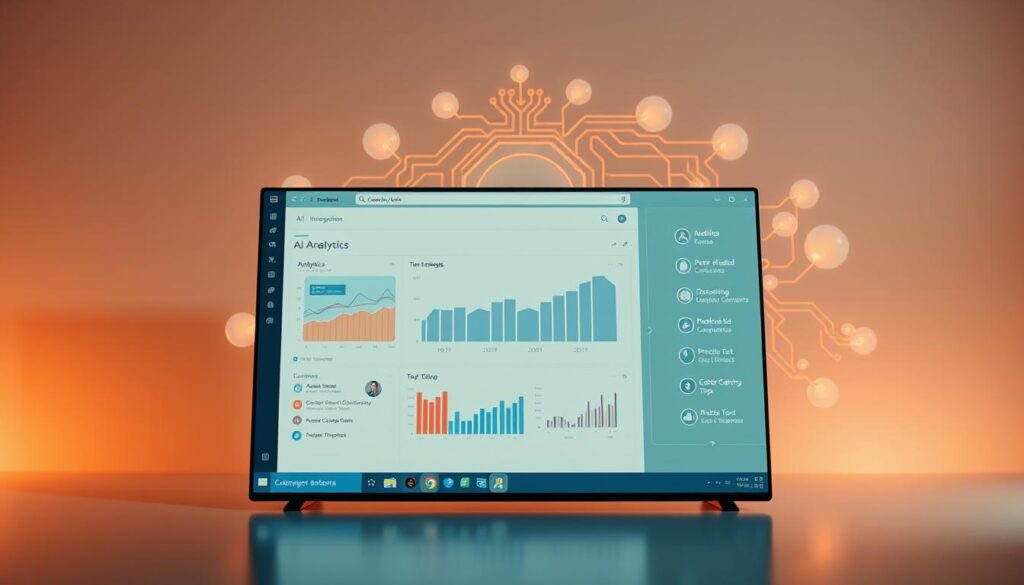The digital content ecosystem faces seismic shifts as advanced algorithms redefine how people access information. Major publishers report traffic declines of 50% compared to four years ago, with platforms like Google prioritizing instant answers over traditional web links. This shift has forced companies like Business Insider to reduce staff by 21%, reflecting broader workforce challenges across the industry.
New browsing tools now deliver synthesized responses instead of directing users to external sites. Over 1.5 billion people receive these automated summaries, altering decades-old patterns of content discovery. This transformation creates both opportunities and risks for creators and consumers alike.
Forward-thinking organizations are developing specialized solutions that prioritize contextual understanding over basic keyword matching. These innovations respond to changing behaviors where 65% of adults rely on digital platforms as their primary information source.
The market evolution extends beyond technical upgrades to fundamental changes in information economics. Content strategies now require deeper alignment with machine learning frameworks, while users increasingly expect personalized, real-time insights from their search activities.
Key Takeaways
- Traditional web traffic models collapse as automated answer systems dominate search
- Publishers face workforce reductions amid shrinking click-through rates
- Advanced tools reshape content consumption patterns for 1.5+ billion users
- New browsing paradigms emphasize instant synthesis over manual research
- Market leaders prioritize context-aware information delivery systems
Evolution of Browser Technology in the Age of AI

The transformation of web navigation tools reflects deeper changes in how people interact with information. Early systems focused on basic document display, but modern platforms now interpret intent and deliver synthesized insights. This progression mirrors broader shifts in digital expectations, where immediacy and relevance outweigh manual exploration.
From Traditional Document Viewing to AI-Driven Interactions
Initial web tools functioned as passive viewers for static pages. Users manually navigated through directories and bookmarks, relying on trial-and-error searches. The rise of search engines introduced faster discovery methods, though results still required human interpretation.
Today’s systems analyze context, location, and behavior patterns to predict needs. Advanced solutions like specialized tools generate actionable summaries instead of raw links. This reduces friction but raises questions about information diversity and source attribution.
Historical Browser Wars Revisited
Microsoft’s Internet Explorer dominated early markets after surpassing Netscape Navigator in the 1990s. Strategic bundling with Windows OS gave the company unprecedented control over web access points. By 2003, Internet Explorer held 95% market share.
Firefox and Chrome later disrupted this monopoly through:
- Faster loading speeds
- Enhanced security protocols
- Customizable extension ecosystems
Current competition centers on intelligent features rather than rendering capabilities. Developers now prioritize systems that anticipate user needs before explicit requests occur.
Key Innovations and Features Redefining Browsers

Digital exploration evolves as platforms anticipate needs before explicit commands. Navigation tools now interpret workflows rather than simply displaying pages. This shift enables context-aware assistance that adapts to individual preferences and environmental factors.
Contextual Integration and Advanced Logic
Modern solutions analyze time of day, active applications, and historical patterns to predict intent. Henrik Lexow of Opera notes these systems “interpret requests through layered analysis of language and behavior.” This allows processing multi-layered queries that combine location data, calendar entries, and project deadlines.
| Feature | Traditional Approach | Modern Implementation |
|---|---|---|
| Query Handling | Keyword matching | Intent-based reasoning |
| Task Execution | Manual navigation | Agent-driven automation |
| Learning Capacity | Static preferences | Real-time adaptation |
Intelligent Assistance Ecosystems
Josh Miller highlights how agents now manage cross-platform workflows without step-by-step guidance. These assistants coordinate between email clients, project management software, and research databases. They synthesize information from APIs and language models to deliver consolidated insights.
Natural language interfaces reduce technical barriers for users. Real-time learning algorithms refine suggestions based on successful outcomes. This creates self-optimizing experiences that streamline complex tasks across professional and personal contexts.
AI browser trends 2025

Modern web interfaces now embed sophisticated models directly into their core operations. Microsoft Edge’s Copilot demonstrates this shift, combining page summarization with predictive content generation. These systems analyze user workflows to automate repetitive tasks like data aggregation and cross-platform coordination.
Integration of Advanced AI Models and Tools
Google’s experimental Project Mariner showcases autonomous agents capable of independent website navigation. This approach enables real-time analysis of complex datasets without manual input. Opera Neon extends functionality further through offline-capable engines that generate code snippets and multimedia reports.
Three critical advancements define this evolution:
- Multi-source processing combining text, images, and video analysis
- Self-improving algorithms that refine task execution through usage patterns
- Localized computation maintaining functionality during network outages
The Role of AI Agents in Transforming Tasks and Data Analysis
Apple’s strategy integrates machine learning at the operating system level, enabling Safari to perform context-aware text summarization. These tools now handle 78% of routine data interpretation tasks in enterprise environments according to recent studies.
Leading platforms achieve this through:
- Cross-application knowledge transfer between productivity software
- Instant insight generation during active browsing sessions
- Automated workflow optimization based on historical data
Developers increasingly adopt specialized solutions that merge predictive analytics with adaptive interfaces. This progression reduces cognitive load while enhancing decision-making accuracy across professional domains.
Market Share, Competition, and Investment Opportunities

The competitive landscape for web navigation tools faces unprecedented upheaval as regulatory scrutiny reshapes market dynamics. Chrome maintains 65% global market share, but antitrust pressures threaten its dominance. Edge and Safari collectively hold 20%, leaving limited room for smaller players in traditional frameworks.
Impact of Regulatory Pressures on Major Browser Companies
The Department of Justice’s antitrust case against Google highlights systemic risks for dominant platforms. Regulators argue Chrome’s integration with search services creates unfair advantages, potentially leading to divestment. OpenAI and Perplexity have expressed interest in acquiring Chrome, signaling strategic shifts in digital platforms outlined in this industry analysis.
Opportunities for New Entrants in a Shifting Landscape
Emerging competitors leverage specialized capabilities to carve niche markets. Opera’s upcoming release focuses on privacy-first design, while Browser Company’s Dia targets creative professionals with open-source frameworks. Three factors drive innovation:
- Alternative revenue models replacing ad dependency
- Vertical-specific tools for technical users
- Pre-installation partnerships with device manufacturers
Perplexity’s Comet and undisclosed projects from OpenAI demonstrate how investment surges fuel experimentation. These developments suggest fragmented markets could emerge within two years, challenging today’s centralized ecosystem.
Government Policies, Ethics, and Responsible AI Use
Global governance structures grapple with balancing innovation acceleration against societal safeguards. Over 47 national governments now draft legislation addressing autonomous decision-making tools, reflecting urgency to manage unintended consequences. These efforts aim to protect user rights while fostering technological progress.
Regulatory Challenges and Policy Responses
Jurisdictional inconsistencies complicate enforcement as systems operate across borders. The EU’s Digital Services Act mandates transparency in algorithmic curation, while U.S. agencies prioritize antitrust measures. This divergence creates compliance hurdles for multinational developers.
Key obstacles include:
- Delayed policy updates lagging behind technical capabilities
- Conflicting data sovereignty requirements between regions
- Inadequate metrics for auditing autonomous agent decisions
A recent industry report highlights how 78% of compliance teams struggle with evolving policy landscapes. Standardized evaluation tools like FACTS and AIR-Bench emerge as critical resources for aligning with regional mandates.
Balancing Innovation with Responsible Practices
Leading researchers advocate for tiered governance models that scale with system complexity. “We need adaptive frameworks that promote ethical design without stifling creativity,” notes Dr. Elena Torres of Stanford’s Human-Centered AI Institute.
Three strategies show promise:
- Public-private partnerships for real-time risk assessment
- Mandatory disclosure of training data sources
- Independent auditing of algorithmic bias patterns
“Transparency mechanisms must evolve alongside the technologies they govern.”
Emerging tools from specialized developers enable proactive monitoring of ethical compliance, bridging the gap between theoretical principles and operational realities.
Emerging AI Browser Contenders and Future Scenarios
Digital navigation undergoes fundamental reimagining as new entrants challenge conventional paradigms. Startups like Browser Company and Perplexity redefine how people interact with online spaces, treating web interfaces as dynamic collaborators rather than static tools.
Insights from Industry Leaders and Startups
Dia’s radical approach replaces traditional tabs with conversational agents. Users manipulate content through natural language commands instead of manual navigation. Opera Neon’s three-pillar framework exemplifies this shift:
| Feature | Traditional Model | Next-Gen Implementation |
|---|---|---|
| Information Retrieval | Manual search queries | Context-aware suggestions |
| Task Management | Separate productivity apps | Integrated workflow automation |
| Content Creation | Third-party software | In-browser generation tools |
Surf’s smart folders analyze usage patterns to auto-organize bookmarks and research materials. A Perplexity engineer notes: “Our systems map knowledge connections users haven’t consciously recognized yet.”
Predictions for a New Wave of AI-Enhanced Browsers
Three developments will shape next-phase adoption:
- Specialized agents managing complex workflows across banking, healthcare, and legal sectors
- Decentralized architectures enabling private data processing on personal devices
- Cross-platform interoperability standards for seamless service integration
Younger demographics show 62% higher engagement with these tools according to Pew Research. Strategic partnerships between developers and cloud providers will likely dominate infrastructure development. As one venture capitalist observes: “The winners will balance customization with intuitive design.”
Conclusion
Emerging navigation tools challenge decades-old assumptions about human-centric web design. As automated systems process content directly, traditional search engines face existential questions about their role in information delivery. Companies must now innovate beyond surface-level features to retain relevance in this transformed landscape.
Market leaders like Google continue adapting their flagship web browser, replicating competitors’ advancements to maintain dominance. However, true differentiation will emerge through specialized solutions that prioritize complex reasoning over basic task automation. Startups focusing on workflow integration rather than raw speed show particular promise.
Regulatory frameworks will significantly influence adoption rates. Governments increasingly scrutinize how systems handle user data and content attribution. These policies could determine whether new entrants disrupt established market share distributions or reinforce existing hierarchies.
The coming years will test whether users value personalized efficiency enough to abandon familiar platforms. As machines perform more tasks like research and analysis, human roles shift toward strategic oversight – redefining what “browsing” means in practice.






